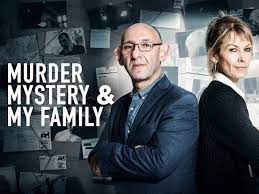
“The British justice system is the envy of the world; but, in the past, mistakes have been made.” So begins every episode of the British series Murder, Mystery, & My Family. It has an interesting, if formulaic, premise: in each episode, a relative of a deceased person who had been convicted of murder (most often hanged, but sometimes imprisoned and later died) seeks to revisit the circumstances of the crime and the trial and, possibly, obtain a judicial decision that the conviction is “unsafe” (i.e., reversible on the basis of a legal error or insufficiency of evidence.) The featured crimes are murders and serious felonies from 1970 and earlier, in which there is a question mark over the conviction.
That the investigation is initiated and driven by a family member, rather than by the legal officials–barristers Sasha Wass, QC, and Jeremy Dein, QC, as well as Judge David Radford–provides a curious emotional hook to the narratives. Even for crimes committed more than a hundred years ago, the relatives begin each episode deeply invested in “clearing the family name”–as if their dead relatives’ crimes can blemish later generations–and become even more convinced of their relatives’ innocence as the investigation progresses. When they speak of their deceased ancestors, they sound like someone testifying for a relative at a sentencing hearing today; in one case, in which several sailors were accused of harassing and raping a woman before driving her to jump off a vessel and drown, the relative referred to one of the sailors, who was hanged before she was born, as “a bit of a lad, but he couldn’t have done this.” Family ties and family shame run deep, and the relatives speak to social historians and crime writers who illuminate some of the period details: why people were having frenzied extramarital affairs shortly after the war, how poverty would have impacted family dynamic, why a doctor’s word about the medication of a patient would matter more than a nurse’s, etc. The relatives also visit the courts and prisons in which events unfolded, invariably exhibiting deep grief and distress when finding a grave or a place of execution.
While this emotional journey unfolds, Wass and Dein investigate the legal aspects of the case. They consult forensics specialists–usually pathologists and ballistics experts–as well as forensic psychologists, who read letters by the victims and perpetrators and opines as to their state of mind. They also take a close look at the court transcript. Their conversations about the evidence are a great display of the ideal roles of prosecutor and defense attorney: Dein zealously searching high and low for reversal grounds, Wass an impartial officer of the court who sometimes agrees with Dein about due process violations but whose prosecutorial lens is unmistakable in her descriptions of events (“and after they got the victim to transfer her estate, they figured they’d bump her off.”) The standard for declaring an historical conviction unsafe, per Judge Redford, seems to resemble the U.S. standard for reversal on collateral review: either a blatant legal error or new evidence that could not have been (and was not) exhausted in the proceedings many decades ago.
In both cases, they face problems of anachronisms and retroactivity. In many of the featured cases, the forensic evidence itself has long been destroyed or lost, and all the experts have to go by are reports written by doctors and scientists who might have been the luminaries of their time, but had to contend with their contemporary methods and technologies (in one memorable episode involving arsenic poisoning, we learn that arsenic occurs naturally in the body, a fact unknown at the time that the victim’s body was exhumed and examined due to uproar and conjecture.) On their face, the reports sometimes show biases (the deceased is said to have been poisoned, when the poison may well have been self-ingested.) In other cases, some forensics remain, but are difficult to analyze because their condition has deteriorated. One is left with the uneasy feeling that hundreds of cases, now final, involving less zealous relatives (and perhaps less made-for-TV facts) could be reversed on the same grounds.
As to the legal grounds, Judge Radford is put in the complicated position of calibrating what counts as due process today with the standards of yesteryear. It’s easier to find legal errors when procedure would have been unacceptable at the time as well as now, such as when the accused was not represented. One example involves the repeated uncovering of what Dein refers to as “police verbals”–unverified paraphrases of what the suspect supposedly said by investigating officers–which seem absurdly unreliable in the face of today’s UK practice of recording all police interrogations. But what about judicial remarks to the jury that would be considered biased today, and merely reflected prevailing values and mores at the time? Many such remarks feature references to gender and class that would have seemed natural and proper to judges in the late 19th century but today are beyond the pale. How Judge Radford dukes this out remains somewhat opaque because, by contrast to the approachable, TV-friendly self-presentations of Wass and Dein, the judge remains in character throughout, and is not part of the debrief at the end of the episode. Nor does his reasoning always satisfy the relatives who, when the conviction is upheld, vow to continue digging into the case.
Anyone interested in legal history, postconviction remedies, and forensics would find this show, despite its contrivances, interesting and well worth watching.




No comment yet, add your voice below!